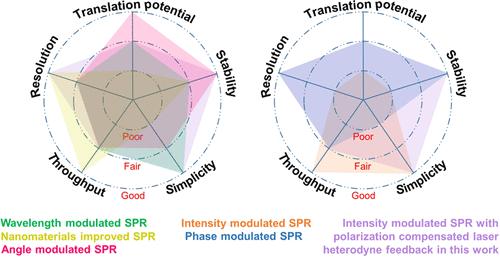当前位置:
X-MOL 学术
›
Anal. Chem.
›
论文详情
Our official English website, www.x-mol.net, welcomes your feedback! (Note: you will need to create a separate account there.)
Ultrasensitive Screening of Endocrine-Disrupting Chemicals Using a Surface Plasmon Resonance Biosensor with Polarization-Compensated Laser Heterodyne Feedback
Analytical Chemistry ( IF 7.4 ) Pub Date : 2023-05-25 , DOI: 10.1021/acs.analchem.3c01292 Jisui Tan 1 , Zongren Dai 2 , Kaiming Zhou 3 , Lin Zhang 3 , Xiaohong Zhou 1 , Yidong Tan 2
Analytical Chemistry ( IF 7.4 ) Pub Date : 2023-05-25 , DOI: 10.1021/acs.analchem.3c01292 Jisui Tan 1 , Zongren Dai 2 , Kaiming Zhou 3 , Lin Zhang 3 , Xiaohong Zhou 1 , Yidong Tan 2
Affiliation

|
Developing an ultrasensitive and reliable device for continuous monitoring of various endocrine-disrupting chemicals (EDCs) is in high demand, yet it remains a significant challenge. Traditional label-free surface plasmon resonance (SPR) sensing relies on the interaction of the surface plasmon wave and the sensing liquid via intensity modulation, endowed with simple structure and easy-to-miniaturization, however suffering from inferior sensitivity and stability. Here, we propose a novel optical structure in which the frequency-shifted light of different polarization returned to the laser cavity to stimulate laser heterodyne feedback interferometry (LHFI), hence amplifying the reflectivity change caused by the refractive index (RI) variations on the gold-coated SPR chip surface, and the s-polarized light could be further used as a reference to compensate for the noise of the LHFI-amplified SPR system, resulting in nearly three orders of magnitude enhancement of the RI sensing resolution (5.9 × 10–8 RIU) compared to the original SPR system (2.0 × 10–5 RIU). To further boost intense signal enhancement, custom-designed gold nanorods (AuNRs), which were optimized by the finite-difference time-domain (FDTD) simulation, were used to generate localized surface plasmon resonance (LSPR). By exploiting the estrogen receptor as the recognition material, estrogenic active chemicals were detected with a 17β-estradiol/L detection limit of 0.004 ng, which is nearly 180-fold lower than that of the system without introducing AuNRs. The developed SPR biosensor is expected to be capable of screening various EDCs with universality by using several nuclear receptors, such as the androgen receptor and thyroid receptor, and will substantially accelerate the assessment of global EDCs.
中文翻译:

使用具有偏振补偿激光外差反馈的表面等离子体共振生物传感器对内分泌干扰化学物质进行超灵敏筛选
开发一种用于连续监测各种内分泌干扰化学物质 (EDC) 的超灵敏且可靠的设备的需求量很大,但这仍然是一项重大挑战。传统的无标记表面等离子体共振(SPR)传感依赖于表面等离子体波与传感液体通过强度调制相互作用,结构简单,易于小型化,但灵敏度和稳定性较差。在这里,我们提出了一种新颖的光学结构,其中不同偏振的频移光返回到激光腔以激发激光外差反馈干涉法 (LHFI),从而放大由金的折射率 (RI) 变化引起的反射率变化-涂层SPR芯片表面,–8 RIU) 与原始 SPR 系统 (2.0 × 10 –5 RIU) 相比。为了进一步增强强烈的信号增强,定制设计的金纳米棒 (AuNR) 通过时域有限差分 (FDTD) 模拟进行了优化,用于生成局部表面等离子体共振 (LSPR)。通过利用雌激素受体作为识别材料,检测到雌激素活性化学物质,17β-雌二醇/L 检测限为 0.004 ng,比未引入 AuNR 的系统低近 180 倍。开发的SPR生物传感器有望通过使用多种核受体,如雄激素受体和甲状腺受体,实现对多种EDCs的普适性筛查,大大加快全球EDCs的评估。
更新日期:2023-05-25
中文翻译:

使用具有偏振补偿激光外差反馈的表面等离子体共振生物传感器对内分泌干扰化学物质进行超灵敏筛选
开发一种用于连续监测各种内分泌干扰化学物质 (EDC) 的超灵敏且可靠的设备的需求量很大,但这仍然是一项重大挑战。传统的无标记表面等离子体共振(SPR)传感依赖于表面等离子体波与传感液体通过强度调制相互作用,结构简单,易于小型化,但灵敏度和稳定性较差。在这里,我们提出了一种新颖的光学结构,其中不同偏振的频移光返回到激光腔以激发激光外差反馈干涉法 (LHFI),从而放大由金的折射率 (RI) 变化引起的反射率变化-涂层SPR芯片表面,–8 RIU) 与原始 SPR 系统 (2.0 × 10 –5 RIU) 相比。为了进一步增强强烈的信号增强,定制设计的金纳米棒 (AuNR) 通过时域有限差分 (FDTD) 模拟进行了优化,用于生成局部表面等离子体共振 (LSPR)。通过利用雌激素受体作为识别材料,检测到雌激素活性化学物质,17β-雌二醇/L 检测限为 0.004 ng,比未引入 AuNR 的系统低近 180 倍。开发的SPR生物传感器有望通过使用多种核受体,如雄激素受体和甲状腺受体,实现对多种EDCs的普适性筛查,大大加快全球EDCs的评估。



























 京公网安备 11010802027423号
京公网安备 11010802027423号